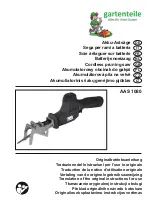
English
– 11
BLADES
General
•
High-quality blades are often most economical. Lower
quality blades often have inferior cutting capacity and a
shorter service life, which results in a higher cost in
relation to the quantity of material that is cut. See the
instructions under the heading Assembling the blades.
Blade instability
•
The blade can wobble and burst if an excessive rotational
speed rating is used.
•
A lower rotational speed rating can stop the wobbling.
Check for correct blade transmission configuration and/or
gear. Otherwise replace the blade.
Diamond blades
General
The cutting blade continues to rotate up to a minute after the
motor has stopped. Never stop the blade with your hands.
Personal injuries can occur.
•
Diamond blades consist of a steel core provided with
segments that contain industrial diamonds.
•
Diamond blades ensure lower costs per cutting operation,
fewer blade changes and a constant cutting depth.
•
When using diamond blades make sure that it rotates in
the direction indicated by the arrow on the blade.
Sharpening diamond blades
•
Always use a sharp diamond blade.
•
Diamond blades can become dull when the wrong feeding
pressure is used or when cutting certain materials such as
heavily reinforced concrete. Working with a dull diamond
blade causes overheating, which can result in the
diamond segments coming loose.
•
Sharpen the blade by decreasing the cutting depth and
engine speed for a short time. This will expose new and
sharp diamonds on the blade
Diamond blades and cooling
•
During cutting the friction in the cut causes the diamond
blade to be heated up. If the blade is allowed to get too hot
this can result in loss of blade tensioning or core cracking.
Therefore the diamond blade needs to be cooled with
water.
Diamond blades for wet cutting
During cutting the friction in the cut causes the diamond blade
to be heated up. If the blade is allowed to get too hot this can
result in loss of blade tensioning or core cracking.
Allow the blade to cool down before touching it.
•
Wet cutting diamond blades must be used with water to
keep the blade core and segments cool during sawing.
Wet cutting blades should NOT be used dry.
•
Using wet cutting blades without water can cause
excessive heat build-up, resulting in poor performance,
severe blade damage and is a safety hazard.
•
Water cools the blade and increases its service life while
also reducing the formation of dust.
•
Use wet sawing of old and new concrete and asphalt.
Transport and storage
•
Store cutting blades in a safe place so it can not be
damage.
•
Store cutting blades in dry, frost free conditions.
•
Inspect new blades for transport or storage damage.
!
WARNING! A cutting blade may burst and
cause injury to the operator.
The cutting blade manufacturer issues
warnings and recommendations for the use
and proper care of the cutting blade. Those
warnings come with the cutting blade.
A cutting blade should be checked before it
is assembled on the saw and frequently
during use. Look for cracks, lost segments
(diamond blades) or pieces broken off. Do
not use a damaged cutting blade.
!
WARNING! Never use a blade for any other
materials than that it was intended for. Never
use a blade with a lower speed rating than
that of the machine. Do not use circular saw
blades or carbide tipped blades.
!
WARNING! Diamond blades become very
hot when used. An overheated blade is a
result of improper use, and may cause
deformation of the blade, resulting in
damage and injuries.
Cutting metal generates sparks that may
cause fire. Do not use the machine near
ignitable substances or gases.
NOTICE! Always use blade flange size specified for current
blade size. Never use damage flanges.
Содержание FS7000 DL
Страница 159: ......












































